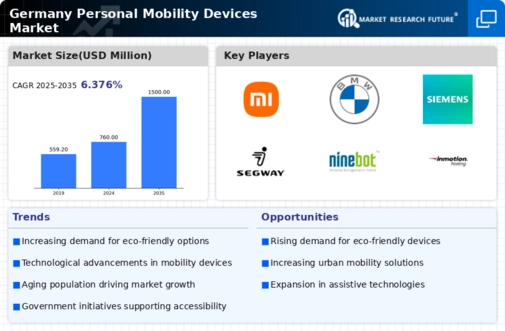Aging Population
Germany's demographic shift towards an aging population significantly influences the personal mobility-devices market. With approximately 22% of the population aged 65 and older, there is a growing need for mobility solutions that cater to the elderly. Personal mobility devices, such as electric scooters and wheelchairs, provide essential support for this demographic, enhancing their independence and quality of life. The market is expected to expand as manufacturers innovate to create user-friendly and accessible devices. Additionally, government initiatives aimed at improving mobility for seniors may further stimulate growth in this sector. The personal mobility-devices market is thus positioned to address the unique needs of an aging society, potentially leading to increased sales and product development.
Environmental Regulations
The stringent environmental regulations in Germany are a crucial driver for the personal mobility-devices market. As the government implements policies aimed at reducing carbon emissions, there is a heightened focus on promoting eco-friendly transportation options. Personal mobility devices, particularly electric models, align with these regulations, offering a sustainable alternative to fossil fuel-powered vehicles. In 2025, the German government aims to have 1 million electric scooters on the roads, reflecting a commitment to cleaner urban transport. This regulatory environment encourages manufacturers to innovate and invest in greener technologies, thereby expanding the personal mobility-devices market. The emphasis on sustainability is likely to resonate with consumers, further driving demand for environmentally friendly mobility solutions.
Technological Advancements
Technological advancements play a significant role in shaping the personal mobility-devices market in Germany. Innovations in battery technology, connectivity, and design are enhancing the functionality and appeal of personal mobility devices. For instance, the integration of smart features, such as GPS navigation and mobile app connectivity, is becoming increasingly common. In 2025, it is estimated that over 30% of personal mobility devices will incorporate advanced technology, making them more attractive to tech-savvy consumers. This trend not only improves user experience but also encourages the adoption of personal mobility devices as a viable transportation option. As technology continues to evolve, the personal mobility-devices market is likely to witness substantial growth driven by consumer demand for smarter, more efficient solutions.
Shift in Consumer Preferences
The shift in consumer preferences towards alternative modes of transportation is a notable driver for the personal mobility-devices market. As awareness of environmental issues grows, many consumers in Germany are seeking sustainable and efficient mobility options. This trend is reflected in the increasing popularity of electric scooters, e-bikes, and other personal mobility devices. In 2025, sales of electric scooters are projected to rise by 40%, indicating a significant shift in consumer behavior. The personal mobility-devices market is responding to this demand by offering a diverse range of products that cater to various lifestyles and preferences. This evolving landscape suggests that manufacturers must remain agile and responsive to changing consumer needs to capitalize on the burgeoning market.
Urbanization and Population Density
The increasing urbanization in Germany is a pivotal driver for the personal mobility-devices market. As cities expand and population density rises, the demand for efficient and compact transportation solutions intensifies. Urban areas are often congested, leading to a preference for personal mobility devices that can navigate through traffic and limited spaces. In 2025, urban areas in Germany are projected to house over 75% of the population, creating a substantial market for personal mobility devices. This trend is further supported by the need for sustainable transport options, as urban residents seek alternatives to traditional vehicles. The personal mobility-devices market is likely to benefit from this shift, as consumers prioritize convenience and efficiency in their daily commutes.























Leave a Comment